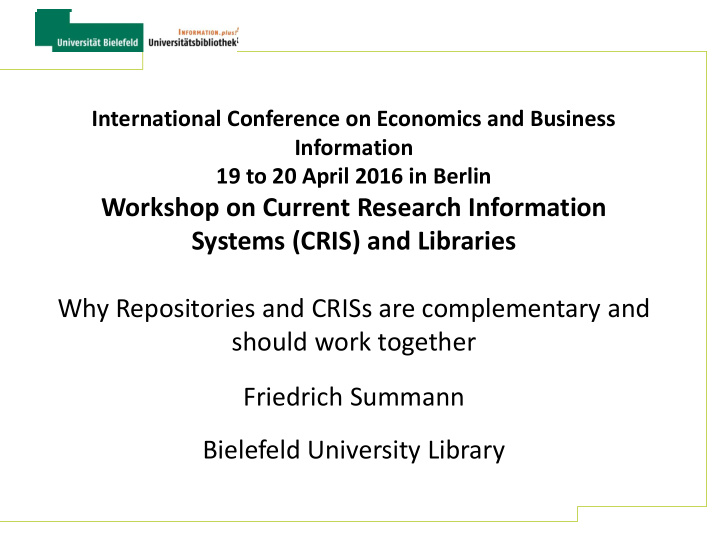



International Conference on Economics and Business Information 19 to 20 April 2016 in Berlin Workshop on Current Research Information Systems (CRIS) and Libraries Why Repositories and CRISs are complementary and should work together Friedrich Summann Bielefeld University Library
CRIS-IR interoperability • The common intersection: Publications • The main challenges: – The metadata format question (CERIF – DC/MODS/MARC) – Related Services and Their Embedding
Bielefeld University Library UNIBI IR – CRIS Activities • Publication Management System (IR with Project Extensions) • Member of the global IR and CRIS network (DINI, COAR, KE) • IR(/CRIS) Service Provider (BASE) • National/European Projects (DRIVER/OpenAire/INTACT/ ORCID-DE)
CRIS IR Internally/Externally-Orientated Externally-orientated Research Office Library Research Information Mgt. Open Access Metadata Fulltext Automatic Harvesting Self/Archive/Mediate Deposit CERIF DC METS MODS Proprietary Software Open Source
The “atomic structure” of the CERIF -XML set of schemas has been criticised by the OAR community as being too much a technically inspired structural copy of the CERIF database structure
Why some institutions prefer to run CRISs • Very comprehensive research information collection • Oriented towards research reporting and evaluation (REF in the UK a big driver for CRISs) • CRISs allow to deal with research funding at internal level -- very valued feature by Research Office managers • CRISs will automatically harvest most institutional publications from external databases (it's about references not necessarily full-text) • CRISs can now work as repositories: CRIS-as-IR use case • CRISs will link to admin systems like HR or Finance • CRISs (often) use CERIF as metadata standard -- very comprehensive and will ensure interoperabiity with funder systems
Why other institutions will keep using their repositories • Emphasis on showcasing and offering Open Access to the institutional research output • CRISs are very expensive and difficult to implement • Repositories can rather effectively (and easily) be managed from the Library • Repositories' publication-centered metadata model may be enhanced to collect additional info: IR-as-CRIS use case • There are now funder mandates requiring Open Access for the next national research assessment exercise http://eprints.soton.ac.uk/271048/
CRIS – IR models of interoperability • CRIS-as-IR CRIS replaces repository and by becoming OAI-PMH- compliant it's able to perform its role (at a basic level now, but evolving) • IR-as-CRIS IR data model and architecture is extended to cover additional aspects (projects, grants, funder programmes, awards, reporting information) • CRIS-IR-Interop Coupled systems exchanging information
CRIS Systems with Repository Functionality • PURE (Elsevier) • Converis (Thomson-Reuters) • Symplectic • DSpace IRIS (Open Source) • Proprietary Solutions / Extended Repository Software
CRIS-IR Solutions in Europe
Three basic use cases: CRIS-as-IR CRIS replaces repository and by becoming OAI-PMH-compliant it's able to perform its role (at a basic level now, but evolving)
Three basic use cases: IR-as-CRIS
Three basic use cases: IR-as-CRIS
Three basic use cases: CRIS-IR-Interop
Activities Impact Publications Award / Indicators recognition Case WoS, arXiv, Studies PubMed, Bibtex, Scopus… Measures Dissemination / Refman Engagement Manual Input Industry / SME’s University Interface Structure [HR] University of HEI – Strategic St Andrews Staff Records Planning, Benchmarking Pulled In CRIS Fed Out [HR] REF, RCUK (Pure) SFC, HESA Student Records [Registry] Public, Media Recognition / Impact Projects, Grants, Full Text Collaborations KT Repository Research Pools [Finance] Research data sets Open Access (multiple locations and formats)
The key challenges (from the IR perspective): • Relationship CERIF – bibliographic metadata formats • Integration of Services (via Interoperability) The conclusion: Communication to exchange experiences and to foster the activities
“Not quite a dichotomy – interoperability the key feature”
“Not quite a dichotomy – interoperability the key feature”
Thank You for Your Attention! friedrich.summann@uni-bielefeld.de
Three basic use cases: IR-as-CRIS IR data model and architecture is extended to cover additional aspects such as researchers, organisations and funding information (projects, grants, funder programmes), thus becoming able to play a basic CRIS role for research reporting purposes
Three basic use cases: IR-as-CRIS
Vorhandene CRIS-Installationen in Europa • UK – 57 • (Pure , Pure-DSpace, Pure-Eprints, • Converis-DSpace, Symplectic-DSpace, etc) • Dänemark – 45 • (Pure) • Deutschland – 4 • (Pure, Converis) • Italien – 60 and more • (Dspace IRIS) • Belgium, Sweden, Netherlands
Recommend
More recommend